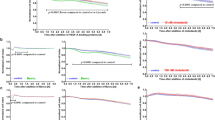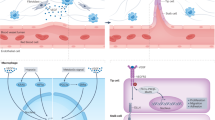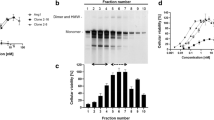Abstract
Retinal neovascularization is a major cause of blindness in such disorders as retinopathy of prematurity, proliferative diabetic retinopathy and senile macular degeneration. Because ligation of vitronectin receptor–type integrins appears to be required for the survival and maturation of newly formed but not quiescent blood vessels in several vascular beds including the retina, blockade of this downstream adhesion receptor system was investigated. In a mouse model of hypoxia–induced retinal neovascularization twice daily administration of 1 to 20 mg cyclic αv–integrin antagonist peptide per kilogram of body weight reduced capillary proliferation in a dose–dependent fashion — maximum 76% — without obvious side effects. A cyclic control peptide displayed no inhibitory effect on neovascularization. These findings indicate that systemic application of vitronectin receptor antagonists appears to be clinically feasible and is efficient in preventing retinal neovascularization and superior to cytokine–blocking strategies.
This is a preview of subscription content, access via your institution
Access options
Subscribe to this journal
Receive 12 print issues and online access
$209.00 per year
only $17.42 per issue
Buy this article
- Purchase on Springer Link
- Instant access to full article PDF
Prices may be subject to local taxes which are calculated during checkout
Similar content being viewed by others
References
Prost, M. Experimental studies on the pathogensis of retinopathy of prematurity. Br. J. Ophthalmol. 72, 363–367 (1988).
Thylefors, B., Negrel, A.D., Pararajasegaram, R. & Dadzie, K.Y. Global data on blindness. Bull. World. Health. Organ. 73, 115–121 (1995).
Moss, S.E., Klein, R. & Klein, B.E. Ten-year incidence of visual loss in a diabetic population. Ophthalmology 101, 1061–1070 (1994).
Brown, G.C., Brown, R.H. & Brown, M.M. Peripheral proliferative retinopathies. Int. Ophthalmol. 11, 41–50 (1987).
The Diabetic retinopathy Study Group. Photocoagulation treatment of proliferative diabetic retinopathy. Clinical application of DRS findings. Ophthalmology 88, 583–600 (1981).
Stone, J. et al. Development of retinal vasculature is mediated by hypoxia-induced vascular endothelial growth factor (VEGF) expression by neuroglia. J. Neurosci. 15, 4738–4747 (1995).
Peèr, J. et al. Hypoxia-induced expression of vascular endothelial growth factor by retinal cells is a common factor in neovascularizing ocular diseases. Lab. Invest. 72, 638–645 (1995).
Bischoff, J. Approaches to studying cell adhesion molecules in angiogenesis. Trends Cell Biol. 5, 69–74 (1995).
Bacharach, E., Itin, A. & Keshet, E. In vivo patterns of expression of urokinase and its inhibitor PAI-1 suggest a concerted role in regulating physiological angiogenesis. Proc. Natl. Acad. Sci. USA 89, 10686–10690 (1992).
Pierce, E.A., Avery, R.L., Foley, E.D., Aiello, L.P. & Smith, L.E.H. Vascular endothelial growth factor/vascular permeability factor expression in a mouse model of retinal neovascularization. Proc. Natl. Acad. Sci. USA 92, 905–909 (1995).
Schultz, G.S. & Grant, M.B. Neovascular growth factors. Eye 5, 170–180 (1991).
Pfeiffer, A. & Schatz, H. Diabetic microvascular complications and growth factors. Exp. Clin. Endocrinol. Diabetes 103, 7–14 (1995).
Berka, J.L. et al. Renin-containing Mueller cells of the retina display endocrine features. Invest. Ophthalmol. Vis. Sci. 36, 1450–1458 (1995).
Robbins, S.G. et al. Platelet-derived growth factor ligands and receptors immunolocalized in proliferative retinal diseases. Invest. Ophthalmol. Vis. Sci. 35, 3649–3663 (1994).
Spranger, J., Meyer-Schwickerath, R., Klein, M., Schatz, H. & Pfeiffer, A. TNF-α level in the vitreous body: Increase in neovascular eye diseases and proliferative diabetic retinopathy. Med. Klin. 90, 134–137 (1995).
Leavesley, D.I., Ferguson, G.D., Wayner, E.A. & Cheresh, D.A. Requirement of the integrin β3 subunit for carcinoma cell spreading or migration on vitronectin and fibrinogen. J. Cell Biol. 117, 1101–1107 (1992).
Felding-Habermann, B. & Cheresh, D.A. Vitronectin and its receptors. Curt. Opin. Cell Biol. 5, 864–868 (1993).
Brooks, P.C., Clark, R.A.F. & Cheresh, D.A. Requirement of vascular integrin αvβ3 for angiogenesis. Science 264, 569–571 (1994).
Casaroli Marano, R.P. & Vilaro, S. The role of fibronectin, laminin, vitronectin and their receptors on cellular adhesion in proliferative vitreoretinopathy. Invest. Ophthalmol. Vis. Sci. 35, 2791–2903 (1994).
Casaroli Marano, R.P., Preissner, K.T. & Vilaro, S., Fibronectin, laminin, vitronectin and their receptors at newly-formed capillaries in proliferative diabetic retinopathy. Exp. Eye Res. 60, 5–17 (1995).
Brooks, P.C. et al. Integrin αvβ3 antagonists promote tumor regression by inducing apoptosis of angiogenic blood vessels. Cell 79, 1157–1164 (1994).
Friedlander, M. et al. Definition of two angiogenic pathways by distinct αv integrins. Science 270, 1500–1502 (1995).
Millauer, B., Shawver, L.K., Plate, K.H., Risau, W. & Ullrich, A. Glioblastoma growth inhibited in vivo by a dominant-negative Flk-1 mutant. Nature 367, 576–579 (1994).
Smith, L.E.H. et al. Vascular endothelial growth factor/vascular permeability factor is temporally and spatially correlated with ocular angiogenesis in a primate model. Invest. Ophthalmol. Vis. Sci. 35, 101–111 (1994).
Aumailley, M. et al. Arg-Gly-Asp constrained within cyclic pentapeptides: Strong and selective inhibitors of cell adhesion to vitronectin and laminin fragment P1. FEBS Lett. 291, 50–54 (1991).
Sasisekharan, R., Moses, M.A., Nugent, M.A., Cooney, C.L. & Langer, R. Heparinase inhibits neovascularization. Proc. Natl. Acad. Sci. USA 91, 1524–1528 (1994).
Iruela-Arispe, M.L., Bornstein, P. & Sage, H. Thrombospondin exerts an anti-angiogenic effect on cord formation by endothelial cells in vitro. Proc. Natl. Acad. Sci. USA 88, 5026–5030 (1991).
Dameron, K.M., Volpert, O.V., Tainsky, M.A. & Bouck, N. Control of angiogenesis in fibroblasts by p53 regulation of thrombospondin-1. Science 265, 1582–1584 (1994).
Moses, M.A., Sudhalter, J. & Langer, R. Identification of an inhibitor of neovascularization from cartilage. Science 248, 1408–1410 (1990).
Johnson, M.D. et al. Inhibition of angiogenesis by tissue inhibitor of metalloproteinase. J. Cell. Physiol. 160, 194–202 (1994).
O'Reilly, M.S. et al. Angiostatin: a novel angiogenesis inhibitor that mediates the suppression of metastases by a Lewis lung carcinoma. Cell 79, 315–328 (1994).
Aiello, L.P. et al. Vascular endothelial growth factor in ocular fluid of patients with diabetic retinopathy and other retinal disorders. N. Engl. J. Med. 331, 1480–1487 (1994).
Jonczyk, A. et al. Zyklische Adhäsionsinhibitoren. EP 0 632 053 (1993).
Preissner, K.T., Anders, E., Grulich-Henn, J. & Müller-Berghaus, G. Attachment of cultured human endothelial cells is promoted by specific association with S protein (vitronectin) as well as with the ternary S protein-thrombin-antithrombin III complex. Blood 71, 1581–1589 (1988).
Author information
Authors and Affiliations
Rights and permissions
About this article
Cite this article
Hammes, HP., Brownlee, M., Jonczyk, A. et al. Subcutaneous injection of a cyclic peptide antagonist of vitronectin receptor–type integrins inhibits retinal neovascularization. Nat Med 2, 529–533 (1996). https://doi.org/10.1038/nm0596-529
Received:
Accepted:
Issue Date:
DOI: https://doi.org/10.1038/nm0596-529
This article is cited by
-
Preparation and cellular-interaction investigation of 177Lu/FITC labeled NGR peptides
Journal of Radioanalytical and Nuclear Chemistry (2020)
-
Human adipose tissue-derived stromal cells act as functional pericytes in mice and suppress high-glucose-induced proinflammatory activation of bovine retinal endothelial cells
Diabetologia (2018)
-
Absence of macrophage migration inhibitory factor reduces proliferative retinopathy in a mouse model
Acta Diabetologica (2017)
-
The microRNA-7-mediated reduction in EPAC-1 contributes to vascular endothelial permeability and eNOS uncoupling in murine experimental retinopathy
Acta Diabetologica (2017)
-
HIF inhibitors for ischemic retinopathies and cancers: options beyond anti-VEGF therapies
Angiogenesis (2016)



